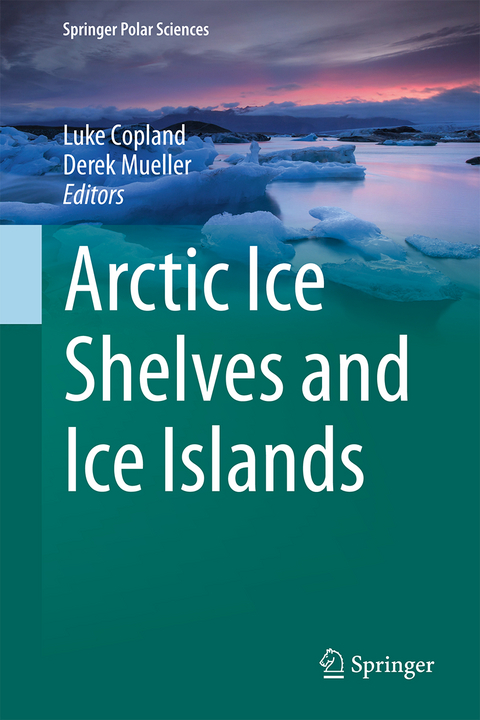
Arctic Ice Shelves and Ice Islands
Springer (Verlag)
978-94-024-1099-0 (ISBN)
Dr. Luke Copland is a Professor and Director of the Laboratory for Cryospheric Research in the Department of Geography, Environment and Geomatics at the University of Ottawa. His research is focused on understanding the dynamics and recent changes of ice shelves, glaciers and ice caps across northern Canada, and he currently runs field research programs in the Yukon and on Axel Heiberg and Ellesmere Islands. Dr. Derek Mueller is a Professor in the Department of Geography and Environmental Studies at Carleton University in Ottawa. He has conducted research on the Ellesmere Island ice shelves since 2001, first on their biology during his doctoral studies, and then on their disintegration using remote sensing, climate and field observations. He continues to do field work at Canada's northernmost coast where he is focused on ice-ocean interactions. He also examines the drift and deterioration of ice islands and icebergs in the Arctic and along the East Coast of Canada.
Part 1. Distribution and Characteristics of Arctic Ice Shelves.- Chapter 1. Arctic Ice Shelves: an Introduction (Julian A. Dowdeswell).- Chapter 2. The Ellesmere ice shelves, Nunavut, Canada (Martin O. Jeffries).- Chapter 3. Eurasian Arctic Ice Shelves and Tidewater Ice Margins (Julian A. Dowdeswell).- Chapter 4. Greenland Ice Shelves and Ice Tongues (Niels Reeh).- Part 2. Physical Processes and Historical Changes of Arctic Ice Shelves.- Chapter 5. Changes in Canadian Arctic Ice Shelf Extent Since 1906 (Derek Mueller).- Chapter 6. The Surface Mass Balance of the Ward Hunt Ice Shelf and Ward Hunt Ice Rise, Ellesmere Island, Nunavut, Canada (Carsten Braun).- Chapter 7. Holocene History of Arctic Ice Shelves (John England).- Chapter 8. An Overview of Paleoenvironmental Techniques for the Reconstruction of Past Arctic Ice Shelf Dynamics (Dermot Antoniades).- Chapter 9. Arctic Ice Shelf Ecosystems (Anne D. Jungblut).- Part 3. Arctic Ice Shelf Calving Processes and Ice Islands.- Chapter 10.Factors Contributing to Recent Arctic Ice Shelf Losses (Luke Copland).- Chapter 11. Ice Island Drift Mechanisms in the Canadian High Arctic (Wesley Van Wychen).- Chapter 12. Recent Changes in Sea Ice Plugs along the Northern Canadian Arctic Archipelago (Luke Copland).- Chapter 13. The Military Importance and Use of Ice Islands During the Cold War (William F. Althoff).- Chapter 14. Russian Drifting Stations on Arctic Ice Islands (Igor M. Belkin).- Chapter 15. Risk Analysis and Hazards of Ice Islands (Mark Fuglem).
“The chapters are well illustrated with color and black-and-white images, maps, and graphs; thorough chapter references are also included. Given the rate of climate change across the Arctic, this book is an extremely timely contribution and will interest a range of individuals. It is especially important for those involved in research on the broad but critical Arctic cryosphere/ocean/atmosphere interactions. … Recommended. Upper-division undergraduates through faculty and professionals.” (J. T. Andrews,Choice, Vol. 55 (11), July, 2018)
| Erscheinungsdatum | 26.05.2017 |
|---|---|
| Reihe/Serie | Springer Polar Sciences | Springer Polar Sciences |
| Zusatzinfo | 77 Illustrations, color; 64 Illustrations, black and white; XII, 422 p. 141 illus., 77 illus. in color. |
| Verlagsort | Dordrecht |
| Sprache | englisch |
| Maße | 155 x 235 mm |
| Themenwelt | Naturwissenschaften ► Biologie ► Ökologie / Naturschutz |
| Naturwissenschaften ► Geowissenschaften ► Geografie / Kartografie | |
| Naturwissenschaften ► Geowissenschaften ► Geologie | |
| Naturwissenschaften ► Geowissenschaften ► Geophysik | |
| Naturwissenschaften ► Physik / Astronomie ► Angewandte Physik | |
| Schlagworte | Arctic • Arctic ocean • climate change • Cold War • Glaciers • Icebergs • Ice Islands • ice shelf • sea ice |
| ISBN-10 | 94-024-1099-6 / 9402410996 |
| ISBN-13 | 978-94-024-1099-0 / 9789402410990 |
| Zustand | Neuware |
| Haben Sie eine Frage zum Produkt? |
aus dem Bereich


